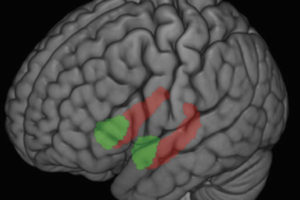A cold dose of fear lends an edge to the here-and-now – say, when things go bump in the night.
“That edge sounds good. It sounds adaptive. It sounds like perception is enhanced and that it can keep you safe in the face of danger,” says Alexander Shackman, a researcher at the Center for Healthy Minds at the University of Wisconsin–Madison.
But it sounds like there’s also a catch, one that Shackman and his coauthors – including Richard Davidson, UW–Madison psychology and psychiatry professor – described in the Jan. 19 edition of the Journal of Neuroscience.
“It makes us more sensitive to our external surroundings as a way of learning where or what a threat may be, but interferes with our ability to do more complex thinking,” Davidson says.
Faced with the possibility of receiving an unpleasant electric shock, the study’s subjects showed enhanced activity in brain circuits responsible for taking in visual information, but a muted signal in circuitry responsible for evaluating that information. Remove the threat of shock (and thus the stress and anxiety) and the effect is reversed: less power for vigilance, more power for strategic decision-making.
The shift in electrical activity in the brain, captured by a dense mesh of sensors placed on the scalp, may be the first biological description of a paradox in experimental psychology.
"You’re having trouble focusing on the information coming in, but your brain is taking in more and more potentially irrelevant information. You can have a viscous feedback loop, a sort of double-whammy effect."
It has long been known that imminent danger can enhance the ability to detect faint stimuli in the environment, such as the crackle of a leaf signaling the approach of a predator. But it is equally clear that the stress and anxiety aroused by a threat can profoundly disrupt the ability to think clearly and perform more complex “executive” tasks.
“In the last few years, theorists have hypothesized this paradox might reflect several systems working in conjunction: one responsible for the rapid detection of external stimuli, the other responsible for the slower, more reflective evaluation of that incoming information,” Shackman says. “Stress upsets the balance of those systems.”
In fact, as the senses go into overdrive, they are probably confounding the rest of the brain all the more.
“Your ability to do more complex tasks is disrupted just as the amount of information you’re receiving through your eyes and ears is enhanced,” Shackman says. “You’re having trouble focusing on the information coming in, but your brain is taking in more and more potentially irrelevant information. You can have a viscous feedback loop, a sort of double-whammy effect.”
The resulting confusion favors quick, reflexive actions, the “survival instincts” often mentioned by trauma survivors – Noise? RUN! – in a way that was likely adaptive in the dangerous environments in which the ancestors to modern humans evolved.
“In our evolutionary past, the dangers we faced were really survival-threatening,” Davidson says. “That’s not so much the case now. Because of the nature of our brains, we can use our neural capacity to create our own internal danger. We can worry about the future and ruminate about the past.”
Either one is likely to present a real hurdle to effective decision-making under stress.
“This is part of a growing body of evidence showing that stress does have important consequences for the brain, not just something that arouses the body – tension in your muscles or butterflies in the stomach,” says Davidson, who studies the effects of meditation as director of UW-Madison’s Center for Healthy Minds.
“One of the things we would expect is that if we use an antidote like systematic meditation training to learn to control stress it would not just calm the body, but improve our ability to engage in complex analytical activity,” he says.
Jeffrey S. Maxwell of the U.S. Army Research Laboratory joined Shackman as lead author of the study, which was funded by the Department of Defense, National Institutes for Health and National Science Foundation.
– Chris Barncard






